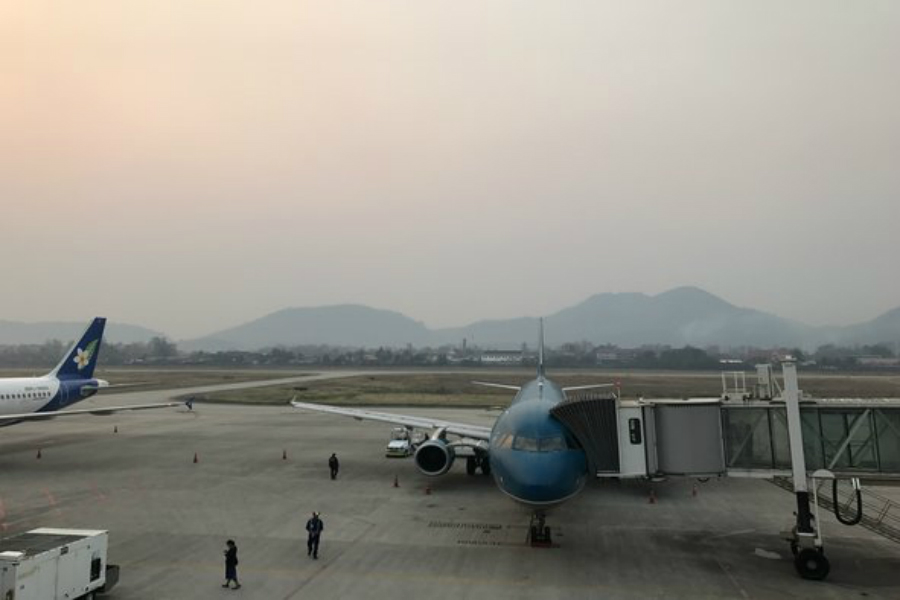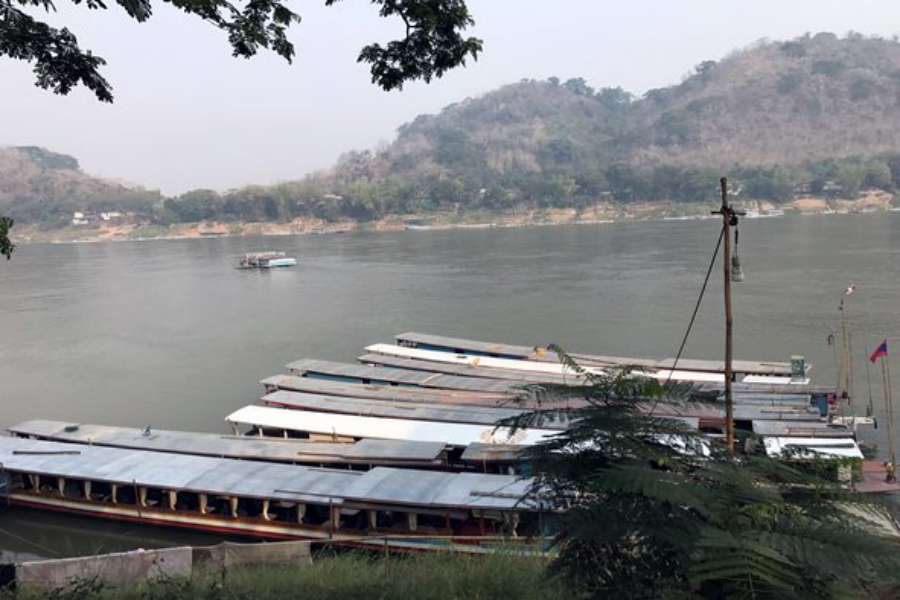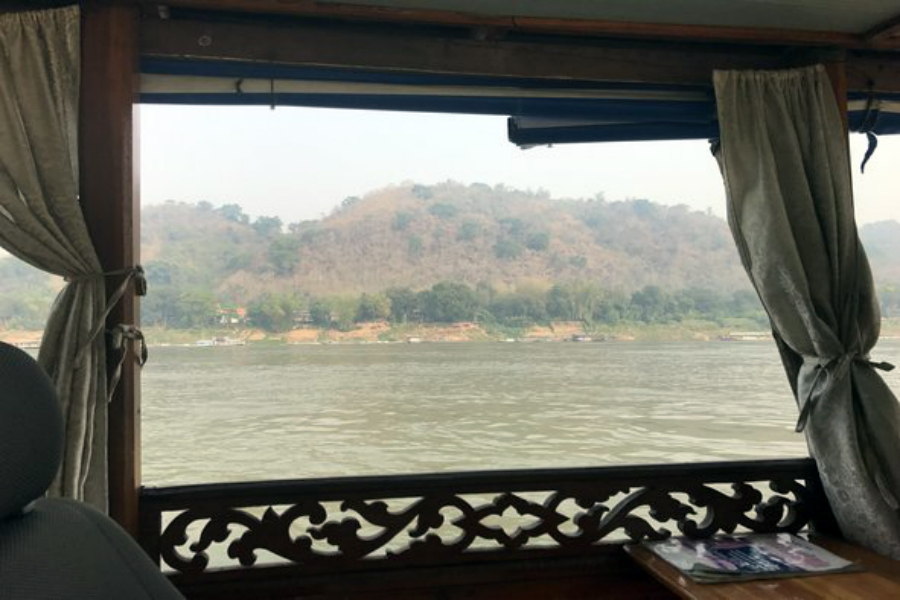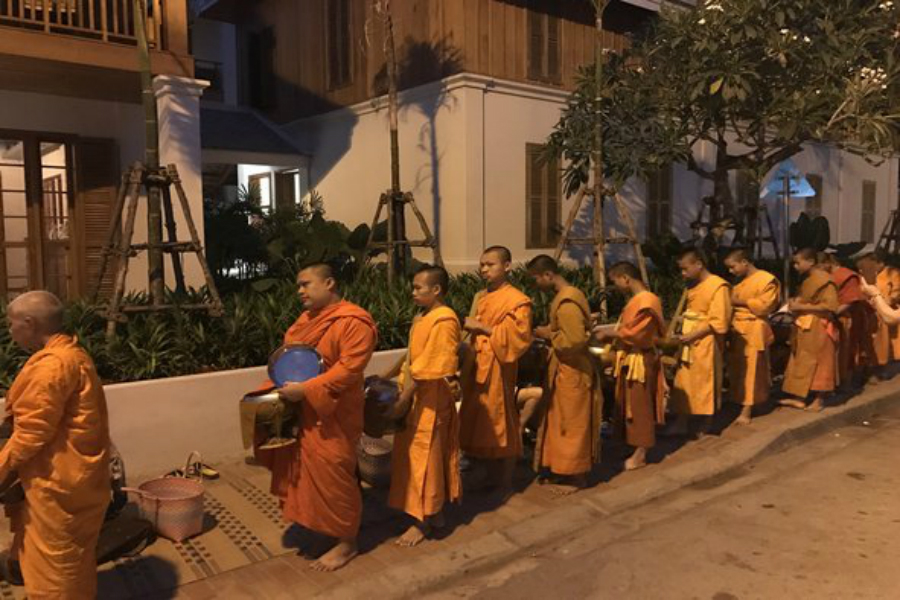The mountains in this Northern Laotian town on the Mekong River exude profound beauty that conceals the remnants of a hidden war and frames the ancient traditions of an unassuming community.

The mountains surround Luang Prabang’s small airport (Photo: Christopher Kompanek)
Surrounded by thick clusters of lush green mountains, Luang Prabang feels like a secret. The hidden nature of this UNESCO protected town is most apparent when arriving by plane. The fog of clouds fades as wild hills, which cover 70% of Laos, snap into focus. It’s not until the plane is nearly on the ground that the structure of civilization becomes visible.
The Mountains Contain a Dark History
Throughout my three days in this magical pocket of Southeast Asia, I unsuccessfully try to capture the mesmerizing force of the mountains. They appear with such vibrant yet nuanced brilliance as if painted onto the landscape by a legendary impressionist artist resurrected from the dead. Likewise, it’s impossible to capture the dark history these mountains contain. During the Vietnam War, the United States secretly dropped hundreds of millions of bombs on the country, and the unexploded bombs killed thousands of people after the war ended. Only 20% of these bombs have been deactivated, according to my Abercrombie and Kent guide, Phonsy. Buried underneath all of this beauty, danger is ever-present.
I think about this as I gaze out the window of my hotel, the Belmond La Residence Phou Vao. Each room is secluded and covered in rich, knotty wood, with beds draped in mosquito netting to ward off malaria. Though Phonsy notes that infections are rare, and the temperature will creep towards 100 degrees, I don long sleeves and pants for our upcoming adventure up the Mekong River. At least the abundance of trees creates a microclimate of sorts that feels way cooler than neighboring Thailand and Cambodia, where I had spent the previous two weeks.
The boat waiting for us at a makeshift dock is a curious vessel. From the outside it looks like a well-worn vehicle for Laotian fisherman, but the seats feel like they’ve been ripped from a nice European train and even recline.

A view of the Mekong River from the boat dock (Photo: Christopher Kompanek)
Time Disappears on the Mekong River
The two-and-a-half hour boat ride to the Buddhist caves of Pak Ou is the best way to view the mountains up close and continuously. I watch them like a movie, and the time flies. Uprooted trees add their own ragged poetry to the landscape, fitting features for one of Tim Burton’s wondrously macabre films. I couldn’t help but feel pangs of guilt for finding this decay beautiful. My gaze shifts down to the water and the sight of floating plastic water bottles abruptly interrupts the meditative tranquility. In Cambodia, gratuitous littering is the norm. These bottles, I soon realize, are holding up a fishing net.

A prime seat to take in the mountainscape (Photo: Christopher Kompanek)
Looking upwards at the sky, I notice dense fog that makes the mountains look even more elusive in their quiet grandeur. The fog turns out to be smoke caused by farmers burning forest, clearing space to grow rice. Gazing intently, trying to absorb the view, I am reminded of Jean-Michel Basquiat’s graffiti paintings and how he would cross out words to draw more attention to them. The lines of peaks can be seen faintly through the haze, even far into the distance, where the land reaches up towards the sky. They form abstract images, whose reflections we float through as we gently move along the Mekong.
It’s sparse by comparison inside the caves, which double as tourist attractions and places of worship. Buddha statues are tucked into dark crevices. In one cave that sits a steep climb from the boat, hundreds of these statues are lined up against a massive wall, poised in various poses that symbolize everything from overcoming fear to attaining enlightenment. According to legend, Buddha would smile when he came to this northern Laotian town to rest. As I sink back into my seat on the boat, I can’t help but feel that this must be true.

Peering out from the cave temple (Photo: Christopher Kompanek)
Because the entire town of Luang Prabang is an UNESCO site, there’s a feeling of being in a time capsule. No building is higher than two stories and the architecture ranges from traditional temples to the understated elegance of the French Colonial buildings, which house the many restaurants that line the streets near the Mekong. Local monks (ranging in age from young children to old men) eat in a different fashion. They walk through the village streets before dawn with bowls to receive small portions of rice from locals and tourists.

Monks collecting alms pre-dawn (Photo: Christopher Kompanek)
More than a tourist photo opportunity (though it is), the experience is not just an act of service, I realize, but a meditation on the roles people play in society. Without it the monks wouldn’t eat. Like meditating itself, there’s a moment during the act where the mind becomes disentangled from action. Then, as the sun gently rises over the town and the surrounding mountains, the monks head back to their temples, the locals begin their day, and though my body leads me back to my hotel room for a nap, my mind lingers in contemplation.